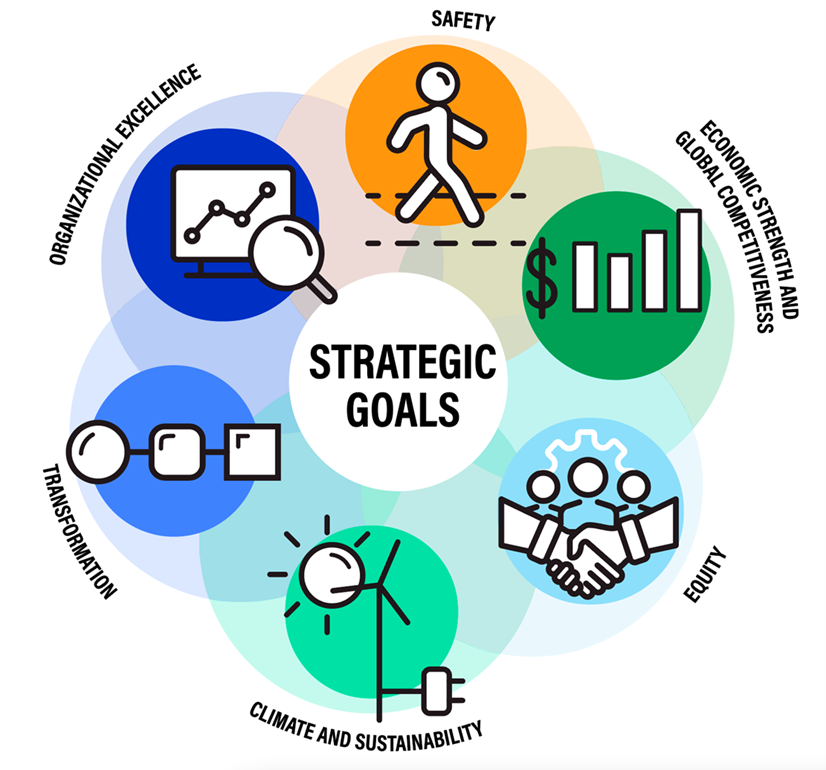
US Department of Transportation released Strategic Plan 2022-2026 to build sustainable infrastructure
Bipartisan Infrastructure Law (the Infrastructure Investment and Jobs Act) provided unprecedented resources to deploy the infrastructure including public transport and highways. USDOT (US Department of Transportation) has released Strategic Plan 2022-2026 to set the goals and objectives for the next 5 years, focusing on safety, equity, climate and sustainability, economic growth, and transformation.
The strategic plan outlines the plan to create more jobs, invest in physical infrastructure to improve safety, and tackle the climate crisis and bus and vehicle fleet electrification. U.S. DOT oversees and administers programs, policies, and regulations in nine Operating administrations (OAs), each with its own management and organizational structure.

Some of the key targets under Strategic Plan 2022-26 are as follows:

Safety
- In 2020, a year when vehicle travel was down overall, 38,824 people died in motor vehicle crashes—more than 100 deaths per day. To prevent this crisis, USDOT released its National Roadway Safety Strategy (NRSS) in January 2022 to achieve an ambitious long-term goal of reaching zero roadway fatalities.
- One of the keys aims is to increase transit ridership in the top transit cities back to 100% of 2019 levels by 2026. Also, USDOT aims to increase the percentage of personal trips by transit and active transportation modes from roughly 4% in 2020 to 6%.
Economic Growth
- The US ranks 13th when it comes to the overall quality of our transportation infrastructure. Transit systems have a repair backlog of more than $105 billion, representing more than 24,000 buses, 5,000 rail cars, 200 stations, and thousands of miles of track, signals, and power systems in need of replacement.
- The plan aims to increase the efficiency and reliability of transportation systems by increasing the frequency of bus service in urbanized areas with over 100,000 in population by 10% by 2026. Further, it set the target to reduce state of good repair backlog for transit revenue vehicles by 25% and transit buildings and facilities by at least 50% by 2030.
Equity
- USDOT is committed to ensuring that transportation projects and programs increase opportunity; advance racial equity and environmental justice; serve rural, urban, and suburban communities equitably; and promote affordable access for all.
- The department aims to reduce the national transportation cost burden by 5%, including transportation travel costs as a percent of income by 2030.
- USDOT aims to increase wealth creation opportunities for underserved communities through direct procurement mechanisms. By September 30, 2023, USDOT commits to raising small disadvantaged business utilization contract award dollars from 18.2 percent in FY 2021 to 20.5 percent.
Climate and Sustainability
- The transportation sector is the biggest contributor to greenhouse gas (GHG) emissions. There is a need to develop a decarbonization strategy for the transportation sector and incentivize stakeholders in their efforts to reduce emissions.
- USDOT aims to increase the number of zero-emission bus vehicles in the national transit fleet by 450% to 7,500 vehicles by 2030 and build a national network of 500,000 EV chargers by 2030 to accelerate the adoption of EVs.
Transformation
- To solve major challenges, different stakeholders will require collaboration across the public and private sectors to foster an innovation ecosystem based on open data and shared insights.
- USDOT aims to create a digital forum to engage 10k transportation professionals to share best practices and use cases on smart cities/communities, technology, and data in transportation by 2026.
- The department authorized $50 million per year in funding to establish a new Open Research Initiative to accelerate the achievement of USDOT’s priorities and goals by funding unsolicited research proposals that yield disruptive technologies with high-impact potential.
Organizational Excellence
- Data-driven programs and decision-making is important to guide the efficient management and investment of resources. It is important to invest in talent and skills to provide leadership across the transportation sector.
- USDOT to provide $500 million in funding to the Strengthening Mobility and Revolutionizing Transportation (SMART) Program, to kickstart a new generation of smart city innovation.


